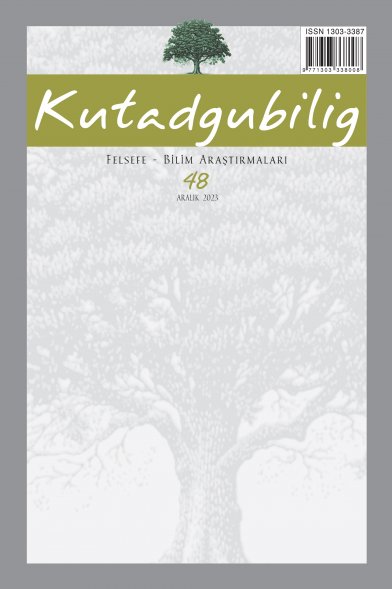ÇAĞDAŞ MATEMATİĞİN TEMELİ OLARAK KÜMELER KURAMI
SET THEORY AS FOUNDATION OF MATHEMATICS
___
Bagaria, Joan: “Set Theory”, The Stanford Encyclopedia of Philosophy (Winter 2017 Editi- on), ed. Edward N. Zalta; https://plato.stanford.edu/archives/win2017/entries/set-theory/ (8 Ocak 2018).Bell, John L.; “The Axiom of Choice”, The Stanford Encyclopedia of Philosophy (Summer 2015 Edition), ed. Edward N. Zalta; https://plato.stanford.edu/archives/sum2015/entries/ axiom-choice/ (8 Ocak 2018).
Biermann, Kurt-R; “Dedekind, (Julius Wilhelm) Richard”, Dictionary of Scientific Biography, ed. Charles Coulston Gillispie, New York: Charles Scribner’s Sons, 1981, c. 4, s. 1-5.
Biermann, Kurt-R; “Kronecker, Leopold”, Dictionary of Scientific Biography, ed. Charles Coulston Gillis- pie, New York: Charles Scribner’s Sons, 1981, c. 7, s. 505-509.
Bourbaki, Nicolas; Algebre (Etat 3) Chapitre 1 Structures Algebraiques, http://sites. mathdoc. fr/archives-bourbaki/PDF/033_iecnr_040.pdf (6 Mayıs 2018)
Broadbent, T. A.; “Russell, Bertrand Arthur William”, Dictionary of Scientific Biography, ed. Charles Coulston Gillispie, New York: Charles Scribner’s Sons, 1981, c. 12, s. 9-17.
Dasgupta, Abhijit; Set Theory: With an Introduction to Real Point Sets, New York: Birkhäuser, 2014.
Dedekind, Richard; “Stetigkeit und irrationale zahlen, braunschweig: Vieweg, 1872.“ R. De- dekind, Gesammelte mathematische Werke, ed. R. Fricke, E. Noether ve O. Ore, Brauns- chweig: Vieweg, 1932 (1930), s. 328-329.
Dedekind, Richard; “Was sind und was sollen die Zahlen?.“ Was sind und was sollen die Zahlen? Stetigkeit und Irrationale Zahlen, Wiesbaden: Vieweg+ Teubner Verlag, 1939.
Ebbinghaus, Heinz-Dieter ve Peckhaus; V., Ernst Zermelo, Springer-Verlag Berlin Heidel- berg, 2007.
Feferman, Solomon; “Lieber Herr Bernays!, Lieber Herr Gödel! Gödel on Finitism, Constru- ctivity and Hilbert’s Program”, Dialectica, c. 62, S. 2, 2008, s. 179-203.
Fenstad, Jens Erik; “Thoralf Albert Skolem 1887-1963: A Biographical Sketch”, Nordic Jour- nal of Philosophical Logic, c. 1, S. 2, 1996, s. 99-106.
Ferreirós, José; Labyrinth of Thought: A History of Set Theory and Its Role in Modern Mathe- matics, Second revised edition, Birkhauser Verlag AG, 2007.
Ferreirós, José; “The Early Development of Set Theory”, The Stanford Encyclopedia of Philosophy (Fall 2016 Edition), ed. Edward N. Zalta; https://plato.stanford.edu/archives/fall2016/ent- ries/settheory-early/ (8 Ocak 2018).
Fraenkel, Abraham Adolf; Recollections of a Jewish Mathematician in Germany, Birkhäuser, 2016.
Freudenthal, Hans; “Hilbert, David”, Dictionary of Scientific Biography, ed. Charles Coulston Gillispie, New York: Charles Scribner’s Sons, 1981, c. 6, s. 388-395.
Friend, Michèle; Introducing Philosophy of Mathematics, Routledge, 2014. Grattan-Guinness, Ivor; “Towards a Biography of Georg Cantor”, Annals of Science, c. 27, S. 4, 1971, s. 345-391.
Gouvêa, Fernando Q.; “Was Cantor Surprised?”, The American Mathematical Monthly, c. 118 S. 3, 2011, s. 198-209.
Hallett, Michael; “Zermelo’s Axiomatization of Set Theory”, The Stanford Encyclopedia of Philosophy (Winter 2016 Edition), ed. Edward N. Zalta; https://plato.stanford.edu/archi- ves/win2016/entries/zermelo-set-theory/ (8 Ocak 2018).
Hermes, Hans; “In Memoriam: Wilhelm Ackermann (1896-1962)”, Notre Dame Journal of Formal Logic, c. 8, S. 1-2, 1967, s. 1-8.
Hofstadter, Douglas R; “Yeni Baskıya Önsöz”, Nagel, Ernest ve Newman. James R., Gödel Kanıtlaması, .çev. Bülent Gözkan, İstanbul: Boğaziçi Üniversitesi Yayınevi, 2008, (oriji- nal baskı tarihi 2001).
Irvine, Andrew David; “Alfred North Whitehead”, The Stanford Encyclopedia of Philosophy (Winter 2015 Edition), ed. Edward N. Zalta; https://plato.stanford.edu/archives/win2015/ entries/whitehead/. (27 Aralık 2017).
Irvine, Andrew David; “Principia Mathematica”, The Stanford Encyclopedia of Philosophy (Winter 2016 Edition), ed. Edward N. Zalta; https://plato.stanford.edu/archives/win2016/entries/princi- pia-mathematica/ (27 Aralık 2017).
Irvine, Andrew David; “Bertrand Russell”, The Stanford Encyclopedia of Philosophy (Fall 2017 Edition), ed. Edward N. Zalta; https://plato.stanford.edu/archives/fall2017/entries/russell/ (27 Aralık 2017).
Irvine, Andrew David ve Deutsch, Harry; “Russell’s Paradox”, The Stanford Encyclopedia of Philosophy (Winter 2016 Edition), ed. Edward N. Zalta; https://plato.stanford.edu/archi- ves/win2016/entries/russell-paradox/ (27 Aralık 2017).
Kanamori, Akihiro; “Set Theory from Cantor to Cohen”, Philosophy of Mathematics, ed. And- rew D. Irvine, Amsterdam: Elsevier/North Holland, 2009, s. 395-459.
Kanamori, Akihiro(originator); “ZFC”, Encyclopedia of Mathematics; http://www.encyclopediaofmath. org/index.php?title=ZFC&oldid=19298 (8 Ocak 2018).
Kennedy, Hubert (ed.); Peano: Life and Works of Giuseppe Peano, c. 4, Springer Science & Business Media, 2012.
Kennedy, Juliette; “Kurt Gödel”, The Stanford Encyclopedia of Philosophy (Winter 2016 Edition), ed. Edward N. Zalta; https://plato.stanford.edu/archives/win2016/entries/goedel/ (27 Aralık 2017).
Kreisel, Georg; “Hilbert’s Programme”, Dialectica, c. 12, S. 3-4, 1958, s. 346-372.
Moore, Gregory H.; “Bernays, Paul Isaac”, Dictionary of Scientific Biography, ed. Charles Coulston Gillispie, New York: Charles Scribner’s Sons, 1981, c. 17 Suplement II, s. 75-78.
Moore, Gregory H.; “Gödel, Kurt Friedrich”, Dictionary of Scientific Biography, ed. Charles Coulston Gil- lispie, New York: Charles Scribner’s Sons, 1981, c. 17 Supplement II, s. 348-357.
North, John David; “Whitehead, Alfred North”, Dictionary of Scientific Biography, ed. Char- les Coulston Gillispie, New York: Charles Scribner’s Sons, 1981, c. 14, s. 302-311.
Laugwitz, Detlef; Bernhard Riemann 1826-1866: Turning Points in the Conception of Mathe- matics, Springer Science & Business Media, 2008.
Robič, Borut; The Foundations of Computability Theory, Springer, 2015.
Sieg, Wilfried; “Hilbert’s Program Sixty Years Later”, The Journal of Symbolic Logic, c. 53, S. 2, 1988, s. 338-348.
Stroll, Robert R. ve Enderton, Herbert; “Neumann-Bernays-Gödel Axioms”, Encyclopædia Britannica;https://www.britannica.com/topic/set-theory/The-Neumann-Bernays-Go- del-axioms (8 Ocak 2018).
Trybulec, Andrzej; “Tarski Grothendieck Set Theory”, Journal of Formalized Mathematics, c. 1, 1989, s. 9-11.
Ulam, Stanislaw; “John von Neumann 1903-1957”, Bulletin of the American Mathematical Society, c. 64, S. 3, 1958, s. 1-49.
Zach, Richard; “Hilbert’s Program Then and Now”, Philosophy of Logic, c. 5, 2006, s. 411- 447.
- ISSN: 1303-3387
- Yayın Aralığı: 2
- Başlangıç: 2002
- Yayıncı: Dergah Yayınları A.Ş.
ZAMAN SORUNU: ŞİMDİCİ VE EBEDİYETÇİ ZAMAN ANLAYIŞLARI
ADALET KILICI VE SAVAŞ KILICI: THOMAS HOBBES’UN POLİTİK OKULUNDA “SAVAŞ HALİ” VE “İÇ SAVAŞ”
CUMHURİYET DÖNEMİ TÜRK DÜŞÜNCESİNDE MİLLİ SANAT/YEREL ESTETİK ARAYIŞLARI*
ARİSTOTELESÇİ İNSAN DOĞASININ ŞEKİLLENMESİNDE ALIŞKANLIK KAVRAMININ ETKİSİ
ONTOLOGICAL EPISTEMOLOGY: NATURAL KINDS AND LAWS OF NATURE
KANT’TA TANRININ İŞLEVİ: SPEKÜLATİF TEOLOJİDEN MORAL TEOLOJİYE
